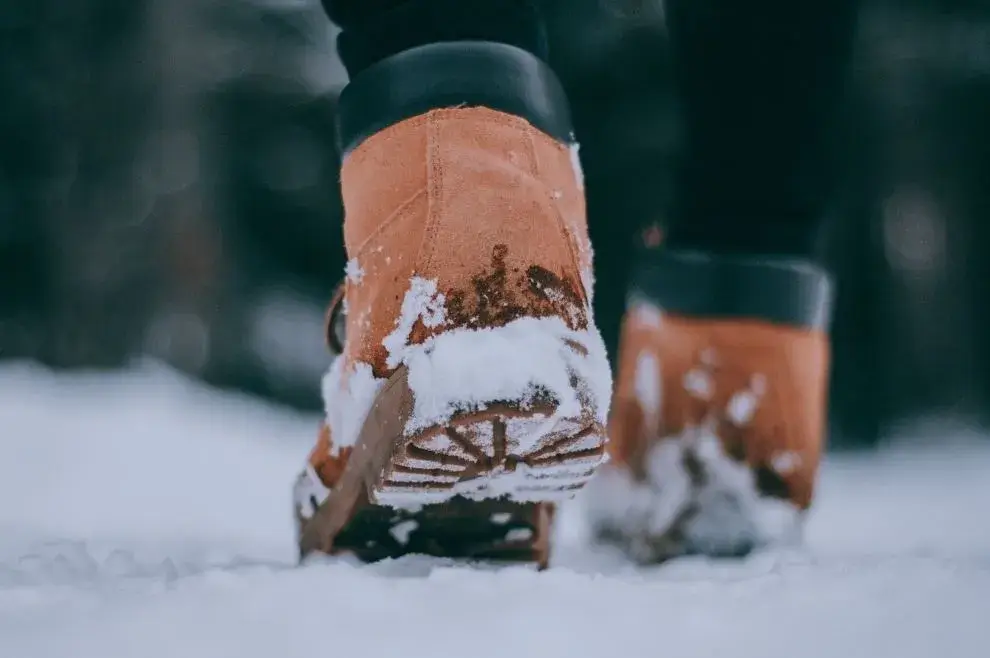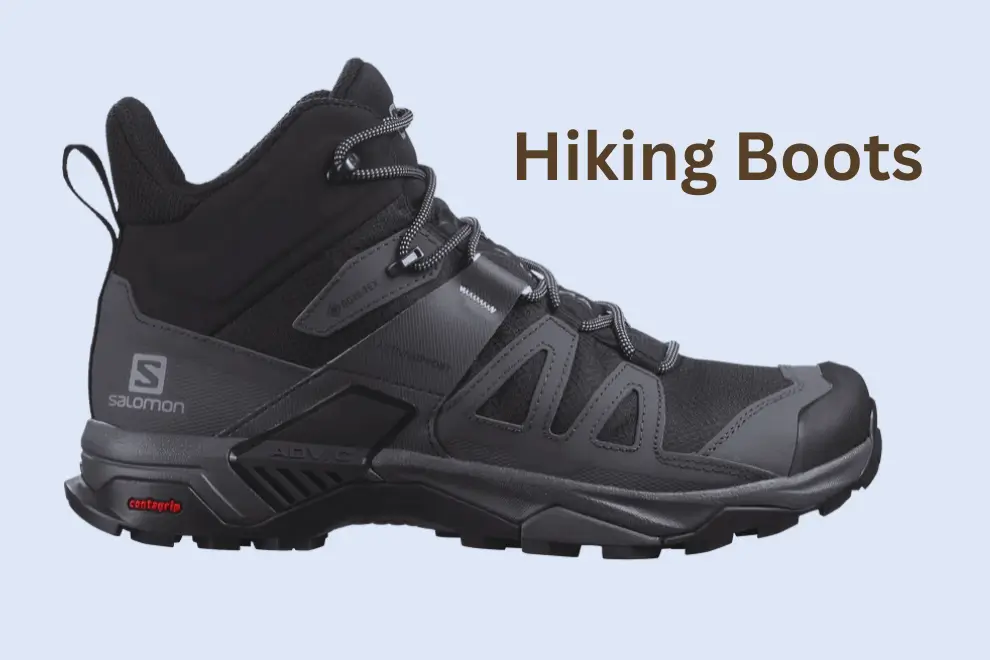
If you’re wondering about hiking boots vs snow boots, which one will you buy? You should consider a few factors.
Hiking boots are typically made of sturdy leather and designed for various terrains. They are usually versatile types of boots. In contrast, snow boots are made to be worn in colder weather and have features like a water-resistant upper and insulation to keep your feet warm.
So, deciding between hiking boots vs snow boots, ask yourself these questions: What will I use them for? How often will I be using them?
Well, I have given a complete comparison battle between snow boots vs hiking boots. Keep reading!
Differences Between Hiking Boots Vs Snow Boots
I have found some key differences between hiking boots vs snow boots. Those differences are in traction, breathability, durability, ankle support, water resistance, soles, weight, flexibility, and affordability. So, let’s dive into the ultimate comparison battle between hiking boots vs snow boots.
Traction
Hiking boots and snow boots both have their advantages when it comes to traction, but they also have some significant differences. Hiking boots are designed to provide good traction on various surfaces, including dirt, rocks, and even snow.
Hiking boots typically have a deep tread that can grip the ground well, even when it’s wet or slippery. However, hiking boots can sometimes be too bulky and heavy for hiking in deep snow.
On the other hand, snow boots are specifically designed for hiking in deep snow. They have a lighter construction and a shallower tread that helps them float on top of the snow. They also typically have unique mats or spikes under the sole that provide extra traction on icy surfaces.
So, if you’re planning to hike in deep snow, then snow boots are probably your best bet. But if you’ll be hiking on a mix of surfaces, then hiking boots will likely provide better traction overall.

Breathability
When hiking, it is essential to have breathable boots to prevent sweaty feet. When walking in the snow, waterproof and warm boots are essential. A major difference between hiking boots and snow boots is their breathability.
Hiking boots are designed to be breathable, so they have mesh panels or perforations to allow air to circulate. This prevents sweaty feet and blisters. Snow boots, on the other hand, are designed to be waterproof. They have a solid construction with few openings to keep out water and snow.
While hiking boots help prevent sweaty feet, they would not be suitable for playing in the snow because they would let in too much cold air. Snow boots would not be ideal for hiking because they would make your feet too hot and sweaty.
Durability
There are quite a few differences between hiking boots vs snow boots in terms of durability. Hiking boots are designed to be tough and sturdy, able to withstand a lot of wear and tear. They typically have a high-quality leather or synthetic upper, a thick rubber sole, and some reinforcement around the toe area.
Snow boots, on the other hand, are designed to be waterproof and insulated. They usually have a thicker sole to provide extra traction in slippery conditions, and they often have a water-resistant or waterproof upper.
Regarding durability, hiking boots are typically more durable than snow boots. However, snow boots will last longer in wet and cold conditions.
Ankle Support
Hiking boots are typically lighter and more flexible than snow boots, which allows for better manoeuvrability on uneven terrain. They have a variety of design for ankle cuff that provides different ankle support on different terrains.
Some have lower ankle cuffs; they are made for short day hikes or light hikes. Some have higher ankle cuffs that are made to provide you ankle support all day long on steep or slippery surfaces.
Snow boots, on the other hand, are designed to provide you with traction and ankle support on wet and slippery surfaces. They usually have higher cuffs to provide you with maximum ankle support. Snow boots are generally more heavy and bulky than hiking boots. They can deliver more ankle support than hiking boots in wet conditions.
Water Resistance
Hiking and snow boots both have their own distinct benefits when it comes to water resistance. As I mentioned above, hiking boots have a variety of designs. Hiking boots are typically made with a waterproof material, such as Gore-Tex, that helps to keep your feet dry even when hiking through wet conditions.
Snow boots, on the other hand, are designed to be completely waterproof. This is important because snow can quickly soak through regular shoes, leading to cold, wet feet. In addition, snow boots often have insulation to help keep your feet warm, even in freezing temperatures.
Some are made for light hikes (they won’t provide you support in wet conditions). Some are specially made for deep hikes (they will provide complete waterproof support). Snow boots are specially designed to wear in wet conditions. So snow boots can give you more waterproof support than hiking boots.
However, for cold, snowy conditions, snow boots remain the best choice for keeping your feet dry and warm.

Outsole
In the hiking boots vs snow boots comparison battle, the outsole is one of the most crucial features to consider. An outsole is the part of a boot that makes contact with the ground. It’s made up of a rubber or synthetic material and has lugs or treads on it to provide traction.
Hiking boots typically have a more aggressive lug pattern than snow boots. The lugs are spaced further apart and are deeper, providing a better grip on loose soil, rocks, and scree. Snow boots, however, have a more compact lug pattern. The lugs are closer together and not as deep. This provides better traction on packed snow and ice.
There is also a difference between hiking boots and snow boots in terms of the outsole material. Hiking boots tend to have a harder rubber compound that is more durable and offers better abrasion resistance. Snow boots usually have a softer rubber compound that is more pliable and provides better traction on slippery surfaces.
When choosing between hiking boots and snow boots, you must consider what type of terrain you’ll be walking on and what weather conditions you will face. If you need a boot for hiking in rocky, loose terrain, then a hiking boot with a more aggressive lug pattern is a good choice.
If you need a boot for walking in snowy or icy conditions, then a snow boot with a softer rubber compound and compact lug pattern is a better option.
Weight
Hiking boots are typically much lighter than snow boots, which can make a big difference when you’re carrying them on your back for hours at a time, as lighter boots will be less tiring to carry. Snow boots tend to be bulkier and more difficult to pack, which can be frustrating when you’re trying to save space in your backpack.
Usually, a pair of hiking boots weigh an average of 3.75 pounds (60 ounces), and a pair of snow boots weigh an average of 4-6 pounds (64-96 ounces). So there have quite significant differences in snow boots vs hiking boots’ weights.

Flexibility
Snow boots and Hiking boots both are flexible. But, there is a minimal difference between hiking boots vs snow boots.
Hiking boots are generally more flexible than snow boots. This is because hiking boots need to be able to bend and twist as you walk, while snow boots don’t. The extra flexibility of hiking boots helps you move more quickly on uneven terrain and prevents your feet from getting tired as quickly.
The design of some snow boots is such that they are more flexible than others. These boots are usually used for activities such as cross-country skiing or snowshoeing. So if you’re looking for a snow boot that’s more flexible than the average, it’s definitely possible to find one.
Affordability
Usually, hiking boots and snow boots both have cheaper to expensive every type of boots. It’s totally up to you which type of boots you will buy. If you want to invest under $100, you’ll find. There are available if you want to invest more than $200.
Cheaper boots, like under $100, probably won’t last long. Eventually, they will force you to buy a new pair. Expensive boots will provide you with so many features and will last long. So, it would be better if you invest between $130-$200.
Snow Boots vs Hiking Boots Comparison Table:
| Features | Hiking Boots | Snow Boots |
| Traction | Very good traction on slippery, rugged, or steep terrains | Very good traction in snow |
| Sealed Cuff | No (Maybe Sometimes) | Yes |
| Ankle Support | Very good ankle support
(Not always – Depends on boots) |
Yes, these boots designed higher up the calf |
| Durability | Extremely Durable (Depends on Budget) | Yes, but less durable than hiking boots. |
| Breathability | Yes | No |
| Rubber sole | Sometimes | Yes |
| Insulation | Comes in both insulate and non-insulate version | Yes |
| Comfort | Comfortable in every weather (depends on budget) | Comfortable in cold weather |
| Water Resistance | Sometimes | Yes |
| Versatility | Usable for various activities | Only for using in snow |
Should You Go Hiking in Snow Boots?
Snow boots are made to wear in snow conditions. You can go hiking wearing snow boots if winter and cold outside. Wearing snow boots on winter hikes, you will feel comfortable, and they will keep your feet dry and warm. But, if it’s summer, snow boots are not preferable for any kind of hike.
Can You Wear Hiking Boots In The Snow?
Yes, you can, by wearing a trusty pair of hiking boots. If your hiking boots have a water resistance feature and they will keep your feet warm and comfortable, you can wear your hiking boots in the snow.
There are so many versatile hiking boots available in the market that are suitable to wear in various weather. Like I have one pair (Salomon quest 4 gore-tex hiking boots). I can wear them in the summer, winter, and Fall. They are versatile boots. If you have hiking boots like that, you can wear them in the snow.
Why do hikers recommend hiking boots over snow boots?
While hiking boots and snow boots may appear to serve the same purpose, there are several key reasons why hikers recommend hiking boots over snow boots.
Usually, Hiking boots are versatile type boots. Hiking boots are designed to provide stability and support on uneven terrain, which is often the case when hiking in mountainous regions.

On the other hand, snow boots are designed for walking on flat, even surfaces such as sidewalks or streets. In addition, hiking boots are typically made from lighter-weight materials than snow boots, making them more comfortable to wear for long periods.
Finally, hiking boots typically have a better foothold than snow boots due to their lugged soles and aggressive tread patterns. For these reasons, hikers recommend hiking boots over snow boots when planning a hike in snowy or mountainous conditions.
Top-rated Snow Boots
Here is some top-rated snow boots list you might be looking for.
- Best Overall Snow Boots: The North Face Chilkat 400 II ($159)
- Best Budget Snow Boots: Kamik Nation Plus ($90)
- Best Everyday Snow Boots: Sorel Caribou Boots ($200)
- Best Boot for Winter Hiking: Merrell Thermo Chill Mid ($120)
- Best Winter Style: UGG Butte Snow Boots ($225)
- Best Snow Boots for Extreme Cold: Baffin Impact ($250)
- Best Insulated Chelsea Boot for Casual Use: KEEN Anchorage III ($175)
- Best Snow Boots for Outdoor Work: Muck Boot Arctic Ice Mid ($200)
Top-rated Hiking Boots
Here is a list of some top-rated hiking boots in the market. That maybe will help you.
- Best Overall Hiking Boots: Salomon X Ultra 4 Mid GTX ($165)
- Best Budget Hiking Boots: Merrell Moab 2 Mid WP ($86.83)
- Best versatile boots (My choice): Salomon Quest 4 GTX ($230)
- Best Cushioned Hiking Boots: Hoka Anacapa Mid GTX ($185)
Ending
Seeing the differences between hiking boots vs snow boots, ultimately, I would say that don’t use your snow boots in warm weather. Wearing snow boots for hiking, your feet will sweat faster, and you’ll feel uncomfortable. It can cause blisters and other health injuries.
If you’re a hiking lover, you must invest in a pair of hiking boots. Hiking boots are usually versatile type boots. You can also use them in snow conditions with some protection, like double-layer socks. Did you ever go hiking in snow boots? Share your hiking experiences in snow boots in the comment section.

